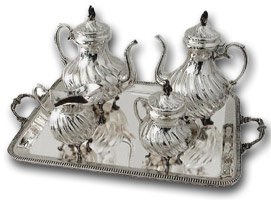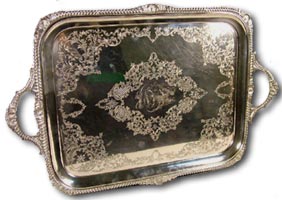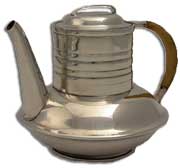Contents
Advice and Tips on Caring for Antique Silver
When caring for antique silver you should be aware that it reacts to different natural conditions in different ways and the care handling and restoration of silver varies accordingly.
Despite its apparent toughness antique silver can be scratched, dented, fractured and can tarnish badly.
If silver is combined with other materials, as in jewellery or furniture, your silver care should be adapted to fit the weakest material. If possible you should detach silver parts form other materials such as sculpture, and clean them separately.
General Silver Cleaning Techniques ...
Always cover your work surface with a soft cloth and always try to wear clean cotton gloves as fingerprints can leave deposits that can cause tarnishing.
Before cleaning any antique silver item, check for loose parts or splits in the metal.
Use proprietary of the shelf silver polishes as little as possible as they work by removing a small amount of the silver.
Dust antique silver regularly with a soft cloth and use a soft bristled brush for awkward places, as it reduces the need for major cleaning.
For grime or light tarnish on antique silver wash in warm water with a little mild detergent added.
Only compeletely immerse your object if it is all silver with no weaker materials. Cotton buds are useful for getting into and cleaning small areas. Always rinse the item and dry thoroughly with absorbent paper.
Never put antique silver in a dishwasher as the salts and detergents may pit and stain the surface.
For heavier duty cleaning on antique silver you can use long term metal polishes that have a built in tarnish inhibitor.
Firstly, use a soft brush to remove dust and dirt that can scratch the surface if rubbed against it.
Never be tempted to dislodge stubborn stains from silver with wire wool or an abrasive cloth.
Then apply your cleaner with a soft cloth or soft brush in gentle circular movements. Rinse and dry the item once with an absorbent paper towel and remove polish from crevices with a dry soft brush.
You can seal antique silver against corrosion with a lacquer.
Remember though that this not only stops the item obtaining a patina but the lacquer is easily scratched and marked by fingerprints and it can soon look patchy.
It's preferable to use a light coating of microcrystalline wax applied after cleaning as an effective and less radical barrier.
Lacquer is worth considering for display items with intricate decoration that would wear away with too much rubbing and cleaning.
Top Tips on Cleaning & Caring for Antique Silver.
1.) To reduce tarnishing on antique silver that is not on display, wrap it in acid-free tissue or undyed cotton or linen.
2.) Sulphurous foods such as egg and brussel sprouts cause tarnishing so the sooner the table silver is washed after contact with them, the better.
3.) Although tarnishing is not actually harmful to silver, over-zealous cleaning is. Particularly with a plated item as too much polishing or rubbing will eventually expose the base metal
4.) Metal polishes should be avoided on pieces that are worn, or niello work or on clocks or watches, where they could seep into the mechanism.
5.) Silver or jewellers cloths and silver dip or foam that can be wiped on large objects with cotton wool swabs, are the least abrasive cleaners. Try to limit the number of items treated per jar of dip, as particles of silver from cleaned items can be deposited on other items and cause unsightly marks that are difficult to remove.
6.) Silver that contains a large proportion of copper can corrode if it is kept in a damp atmosphere. This causes a green crystalline deposit (verdigris). This verdigris can be wiped off silver plate with methylated spirits but if it appears on solid silver it should be chemically treated by a professional metal conservation specialist.
7.) Worn electroplate (EPNS) and Sheffield silver plate can be re-silvered either professionally or by using a proprietary re-plating agent. However, the attraction of a bright new surface must be balanced against the possibility that the finish and colour may not be true to the original and the sharpness of any engraving may be dulled. The process may well de-value an antique silver piece particularly in the case of old Sheffield plate.





Leave a Reply
You must be logged in to post a comment.